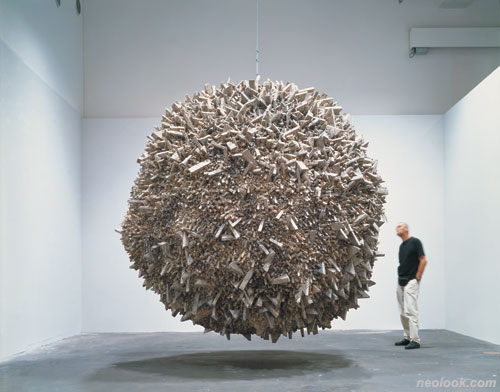- ● homepage
- ● archives
- ● restoration
- ● books
- ● big banners
- ● post board
- ■ neo's search
- ■ about us
- ■ 게재방법 안내
- 개인정보처리방침

- [email protected]
- Tel. 02_335_7922
- Fax. 02_335_7929
- 10:00am~04:30pm
- 월요일~금요일
- 3/3(월) 대체공휴일

A Retrospective
전광영展 / CHUNKWANGYOUNG / 全光榮 / painting.installation 2016_0521 ▶ 2016_0930 / 월요일 휴관
● 위 이미지를 클릭하면 네오룩 아카이브 Vol.20051115c | 전광영展으로 갑니다.
초대일시 / 2016_0520_금요일_05:00pm
관람료 / 성인 5,000원(단체 4,000원) / 학생,어린이 3,000원(단체 2,000원) * 단체 20인 이상
관람시간 / 10:00am~06:00pm / 입장마감_05:30pm / 월요일 휴관
우양미술관 WOOYANG MUSEUM OF CONTEMPORARY ART 경상북도 경주시 보문로 484-7(신평동 370번지) Tel. +82.54.745.7075 www.wooyangmuseum.org blog.naver.com/wymuseum
우양미술관은 한국 미술계의 중추 역할을 해온 중진 원로 작가들을 지원하는 '우양작가시리즈'의 일환으로 원로작가 전광영 작가를 초대하여, 초기작품부터 대형 설치작품까지 반세기 동안 펼쳐온 작품 세계를 총망라하는 회고전을 개최한다. ● 우양미술관이 소장하고 있는 작품을 포함하여 총 60여점의 작품이 선보이는 본 전시는 3년만에 국내에서 개최하는 개인전이다. 오랜 해외 활동 중에도 국내화단과의 조우를 그리워했다는 작가는, 60년대 후반 도미하여 선보이기 시작한 추상표현주의 작업 중 미공개 되었던 작품 8점과 90년대 후반부터 2000년대 초반 작품 중 현존하지 않는 10여점을 재제작 하는 열정을 더해 작가의 시기별 작품을 골고루 선보일 수 있도록 하였다. 2014년 이후 감각적인 색채의 신작과 고서한지로 포장된 유닛(unit)이 아닌 색점(dot)으로 구성된 새로운 시도의 작품 등 12여점의 국내 미공개 신작들도 함께 감상할 수 있다. ● 작가는 아시아적 정체성과 서구적 근대성의 틈에서 방황했던 자전적인 갈등과 충돌의 이야기를 시각적으로 승화시켜왔다. 1944년 생으로 한국전쟁의 소용돌이를 목도하였으며 도제식 미술교육을 피해 69년 도미하여 당시 2차대전 이후 만연했던 추상표현주의의 자유로움에 매료되었다. 그러나 그곳에서도 베트남 전쟁에 대한 반전 분위기, 허무주의가 만연한 히피문화, 인종차별, 물질만능주의적 자본주의의 현실속에서 이방인으로 혼돈의 시기를 겪고 77년 다시 귀국하게 된다. 작가는 이러한 시대적 상황을 통해 서구적 모더니티의 '시각적 차용'에 대한 회의를 느끼고 'The 전광영' 이라 불릴 수 있는 작가 자신만의 정체성을 모색하는 시기를 탐하게 된다. ● 초기작인 7-80년대 추상작업은 붓질을 통한 추상의 구현이 아닌 독특한 작업과정을 통해 나타난 결과물이다. 화학성분을 바르지 않은 캔버스에 테잎 또는 짧고 길쭉한 종이들을 흩뿌린 뒤에 혼합한 날염안료를 드리핑(dripping)한 후 이를 떼어내어 흔적을 남기는 과정을 반복하였다. 이 시기 작품들은 이후 등장하는 가늘고 길쭉한 유닛과 삼각형의 유닛의 집합을 추구하게 된 심미의식의 기저를 형성하게 해주었다.

- 전광영_ONT-010-73-43_캔버스에 유채_151×166cm_1973

- 전광영_ONT-008-83-62_캔버스에 유채_181×152cm_1983
작업을 시작한 지 20여년 만에 추상표현주의적 작업을 과감히 접고 94년부터 '한지로 싸서 끈으로 동여맨 삼각조각'으로 새로운 조형성을 추구하기 시작한다. 이것은 아시아적 혹은 한국적인 정체성에 대한 모색이 반영된 것으로, 자연관과 인생관이 회화관과 일치하여야 함을 중요시하였던 문인화의 특성이 작가의 사유세계에 엿보인다. 작가는 어린 시절 어머니와 자주 드나들던 한약방에서 본 한지에 싸인 약재봉지들에 대한 섬광 같은 끌림에 주목하였다. 한지, 고서종이, 노끈, 향토적 색, 아련한 빛, 명상하듯 반복적인 행위 등을 통해 비로소 그간 추상작품에서는 좁히지 못한 근원적 노스텔지어를 해소하는 국면을 맞게 된다. 수많은 삼각 유닛(unit)들의 집합(aggregation)과 화면을 채우는 올오버(allover)적 제작방법은, 고정될 수 없는 관계지향적 속성을 가진 유기체 내부의 세포들을 연상시킨다. 이 또한 객관적 실체는 존재할 수 없다는 인식적 상대주의의 도가 사상과도 중첩되는 것은 우연일까.
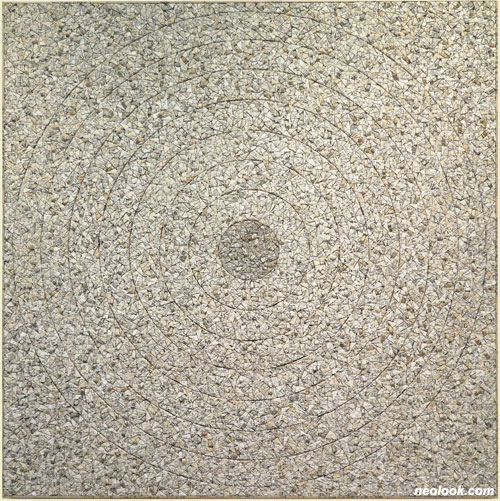
- 전광영_Aggregation 16-MA026_닥지에 혼합재료_151×151cm_1997(2016 재제작)
이후 90-2000년대에 걸쳐 삼각 유닛을 재배치하고 구조화 하는 다양한 시도로, 평면회화도 부조조각도 아닌 새로운 영역을 개척한다. 구성에 대한 다양한 시도가 극대화되는 시기로, 유닛을 집합하여 새로운 기하학적 형상을 만들기도 하고, 집단화 시켜 그 사이 깊은 골을 형성하는 분열적 형태를 취한다. 또한 캔버스 자체를 변형시키거나 고서한지의 색채에서 나아가 오미자, 구기자, 치자, 쑥을 태운 재 등을 사용한 자연염색으로 다채로운 색에 대한 연구가 시도되었다.
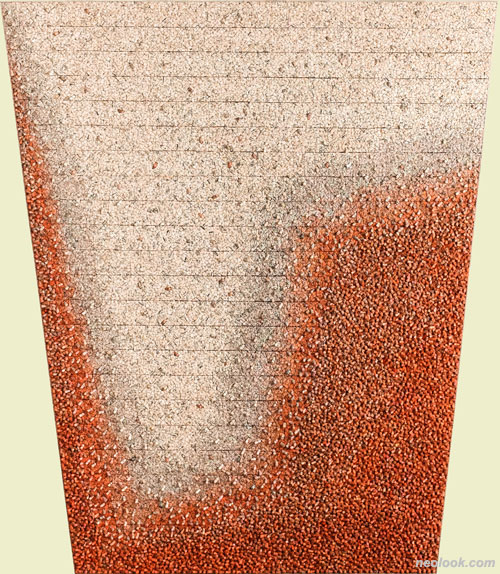
- 전광영_Aggregation 02-MA101B_닥지에 혼합재료_231×201cm_2002
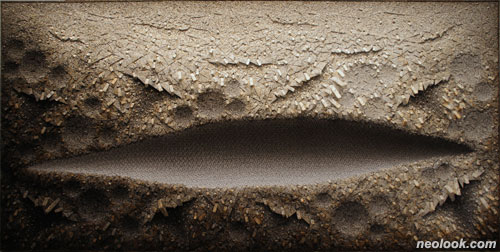
- 전광영_Aggregation 11-DE092_닥지에 혼합재료_202×402cm_2011
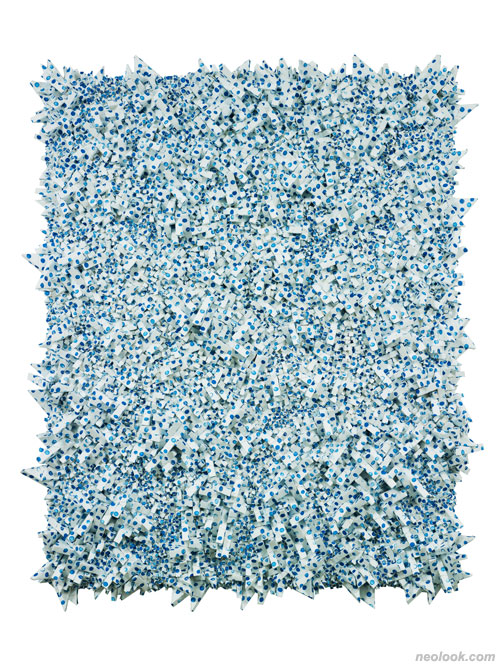
- 전과영_Aggregation 12-NV052_닥지에 혼합재료_244×206cm_2012
2000년대 후반으로 접어들면서 평면적 부조 속에 심연의 웅덩이와 같은 공간감을 추구하는 작품들이 등장하고 나아가 3차원의 대형 입체 설치 작업들로 본격적인 '공간'에 대한 탐구를 시작한다. 이어 점차 4차원 이상의 시간성과 역사성까지 시각화하고자 하는 욕망이 더해진다. 삼각 조각들의 반복과 겹침에 의해 '우연히' 창조되는 공간과 형상은, 창작에 있어 화가의 정신만족은 기교상의 구속을 타파해버린 이후에야 비로소 얻어질 수 있으며1) '기운'을 파악하여 형상을 이루게 되면 의미(神似)와 형상(形似)을 모두 얻어낼 수 있다고 본2) '기운생동3)'의 예술적 효과와 맞닿아있다. ● 얼드리치 미술관(The Aldrich Contemporary Art Museum), 모리아트센터(Mori Arts Center) 등 해외 유수 미술기관에서의 전시를 통해 독자적인 조형철학을 입증 받은 작가는 2010년 이후부터 삼각형 스티로폼을 싸온 한지의 색을 이국적으로 발전시켜, 초기 추상작업을 통해 추구하였던 빛과 색을 향한 자유로움을 다시금 실험한다. 꿈속을 떠다니듯 하늘의 별을 바라보며 영원히 충족되지 못하는 인간의 욕망과 갈등의 알레고리를 'Dream', 'Star', 'Desire' 부제의 작품들을 통해 풀어냈다.

- 전광영_Aggregation 16-AP040(Desire2)_닥지에 혼합재료_151×151cm_2016
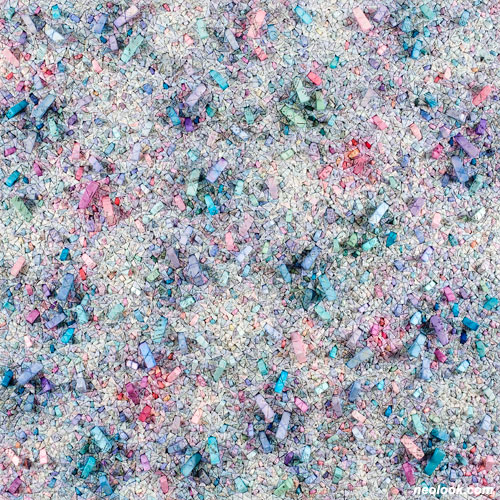
- 전광영_Aggregation 16-AP004(Desire1)_닥지에 혼합재료_151×151cm_2016
거시적 관점에서 작가는 아시아적 사유체계와 한국 전통적 정서를 비움과 해소의 화두를 통해 현대적 화풍으로 안착하는데 성공하였다. 끊임없이 노끈으로 개체를 묶어내는 제작방식을 보건대, 작가에게 작품은 잊혀져 가는 우리의 이야기를 화폭 위에 붙들어 매어 두는 저장장치가 아닐까. 가볍지만 질긴 종이에 담긴 무거운 작가의식을 통하여 보편적 미의식 속에 담긴 특수성을 다시금 고찰해보는 계기가 될 것이다. ■ 우양미술관
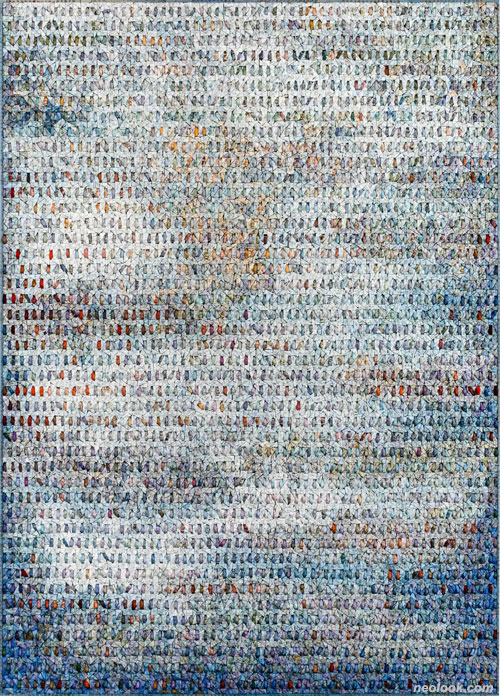
- 전광영_Aggregation 14-JA008(Dream 2)_닥지에 혼합재료_229×164cm_2014
The Wooyang Museum of Contemporary Art is planning to hold a retrospective exhibition of the works of Chun Kwang Young. As part of the Wooyang Artist Series, which is designed to support senior artists who have played central roles in Korean art circles, the retrospective covers a half century of Chun's work, from his early works to the large installations he created later in his career. ● Featuring over 60 works, including those owned by the museum, this exhibition is the first solo exhibition that Chun has held in Korea in the last three years. Chun, who is said to have longed for the company of his Korean contemporaries during the long periods of time he spent in other countries, will be showcasing previously un-exhibited artworks he produced in various stages of his life, including eight of the abstract expressionist works he produced after settling down in the U.S. in the second half of the 1960s, and some 10 re-creations of works he produced during the period from the second half of the 1990s to the first half of the 2000s that no longer exist. He will also unveil 12 artworks, including some new, particularly colorful works that he has created since 2014 and experimental works consisting of colored dots instead of his typical polystyrene shapes wrapped with hanji. ● Chun has lived a life of conflict and tension created by clashes between his Asian identity and Western modernity, but has managed to transcend these difficulties through his art. Born in 1944, he witnessed the chaos of the Korean War and traveled to the U.S. in 1969 to escape the strict apprenticeship system of art education in Korea at the time. There, he was captivated by the liberal spirit of abstract expressionism that prevailed after World War II. However, the Vietnam War protests, nihilistic hippie counterculture, racial discrimination, and bourgeois capitalist reality in the U.S. at the time threw him into confusion, prompting him to return home in 1977. Chun became skeptical about the "visual borrowing" of Western modernity in Korea and started exploring his own unique stylistic identity, which has since become known as "Chun Kwang Young" style. ● His early abstract works from the 1970s and 1980s achieve abstract embodiment through his unique work process rather than brushstrokes. This process involves repeatedly applying short or long strips of paper or tape all over a canvas with no chemical undercoat, dripping mixed printing pigment over them, and then removing them to leave empty spaces across the canvas. His works from this period laid the foundation for the development of his aesthetic style involving the aggregation of long, thin shapes and triangular shapes. ● Starting in 1994, after some 20 years of involvement in abstract expressionism, Chun began a bold transition to a new style, characterized by "triangular shapes wrapped in hanji and bound with string." The artworks he created during this period seem to reflect his search for a unique Korean or Asian identity and a style of literary painting that emphasizes harmony between art, nature, and life. In the creation of these works, Chun was influenced by his memories of medicinal herbs wrapped in hanji that he saw in the herbal medicine shops he used to visit with his mother. His consistent use of hanji, old books, string, traditional colors, and subtle light satiated his nostalgia in a way that his work with abstract expressionism never could. Moreover, his aggregation of countless triangular shapes and use of all-over techniques are reminiscent of the internal cells of an organism, in that they cannot exist in isolation. Through these works, Chun seems to be expressing the cognitive, relativistic idea of Taoism that objective truth does not exist. ● In the 1990s and 2000s, Chun conducted diverse artistic experiments with triangles, systemizing and rearranging triangular shapes to create a new genre that exists somewhere between painting and sculpture. It was during this period that he began aggressively experimenting with composition by aggregating his triangular shapes to create new geometric forms or dividing them into several groups and making deep grooves between them. He also made modifications to the canvas itself and experimented with colors by using colored hanji from antique books or natural dyes he made by boiling schisandra, boxthorn, and gardenia seeds and burning mugwort. ● Starting in the second half of the 2000s, Chun began experimenting with "space," creating broad chasm-like spaces in the plane surfaces of his artworks. This experimentation later progressed to the creation of large installation pieces. He then expanded his experimentation further to visualize temporality and even historicity in four or more dimensions. The spaces and forms he created through the endless repetition and overlapping of triangular pieces correspond to the principle of "Chi and its Vitality," which states that artists can achieve mental satisfaction only when they free themselves from technical constraints and meanings, and that forms can be created only through the union of "chi" with form. ● Having made a name for himself among art circles by holding exhibitions at prestigious art institutions, including the Aldrich Contemporary Art Museum and Mori Arts Center, Chun is now revisiting an experiment with light and color that he once attempted through his abstract works early in his career, but this time he is using colored hanji to wrap polystyrene triangles. In these works, such as Dream, Star, and Desire, he depicts the unresolved human desire and conflict he felt while looking up at the stars in the sky in a kind of dream-like state. ● Looking at the body of his work from a long-term perspective, it can be seen that Chun has succeeded in expressing concepts of Asian philosophy and traditional Korean sentimentality, while giving them a modern twist, by freeing himself from constraints and desire. In particular, his method of wrapping countless triangular shapes with string is a unique and effective means of capturing a narrative on the canvas. It is hoped that this exhibition will offer visitors an opportunity to appreciate the specific universal aesthetics expressed by Chun Kwang Young in his artworks, especially through his profound use of light yet durable paper. ■ WOOYANG MUSEUM OF CONTEMPORARY ART
Vol.20160518e | 전광영展 / CHUNKWANGYOUNG / 全光榮 / painting.installation

